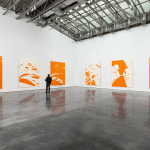Keltie Ferris has been making body prints, and for the first time, this body of work will be included with recent paintings in a forthcoming solo show at Mitchell-Innes & Nash. According to the press release, she uses her whole body like a brush, coating herself with natural oils and pigments, and then presses her clothed body onto the paper.
[Image at top: Keltie Ferris, body print on paper.]
In relying on body prints for her image and paring down her color choices, Ferris has eliminated the energy and ambiguity that are the hallmarks of her large-scale highly-saturated abstract paintings. It’s hard not to imagine Ferris inking herself up and writhing on the floor as she makes the impressions, turning the idea of frottage on its head. Or stomach.
“Keltie Ferris,” Mitchell-Innes & Nash, Chelsea, New York, NY. September 10 – October 17, 2015.
Opening Reception: September 10, 6 – 8 pm.
Related posts:
“Artists are at their most canny and resourceful when backed�or painted�into a corner”
2010: The girls are all right
Jukkala doesn’t name names in New Haven
——
Two Coats of Paint is licensed under a Creative Commons Attribution – Noncommercial-No Derivative Works 3.0 United States License. For permission to use content beyond the scope of this license, permission is required.






























Since more of the body slams are in blue pigment, I can't help but think there is a commentary on Matisse's Blue Nude and Yve's Klein. Seems this could have been done by inking up the clothes laying them flat on paper and compressing the whole mess with a sheet of plywood. These are monoprints of flatness, body image, found shapes, and cloth-canvas-painting schtick, which frankly I find a little trite. This might be an easy assignment in Printmaking 101, what am I missing here? Her new large scale painting seems to continue the saturated illusions vs frontality of her earlier attempt with more slickness, falling into a decorative formula reminding me closely of Olitski's of the late Sixties. This is not totally a bad thing. The notched or pixelated edge embellishments are starting to look a little like a mindless stylism, instead of the raw energy feel of her previous work. Maybe I'm just sick of computer tech/digi references.
Hi Hilary, thanks for reading. Seems like the body prints signal a decisive turn away from digital imagery, no? I'm thinking more "Shroud of Turin" than Yves Klein. Also interesting that she chose to ink her clothed body rather than naked–a reference to feminist artists' use of clothing, fabric, and so forth perhaps. I'm looking forward to seeing what these prints look like IRL.
Bug caught in ointment? Bird slammed into window?
Just guesing, if you inked your clothes, slow drying ink, and tried to lay on flat paper, the smudging from getting into position would obscure everything. So, you mount the paper on the wall, and step into it. This however, won't provide enough pressure to render the body, unless someone pushes from behind-the push/pull being an obvious Hans Hoffmann type joke. I'm still stuck on these images resulting from the inked garments alone being laid on a large press with paper, and with enough pressure, squeezed through the rollers. They seem too flat, especially around the thighs. Speaking of flatness, it is almost embarrassing to say the denim being canvas like entertains a formal reference in the way we can say the body images ackowledge the plane of the image/paper support? Barry Le Va body slams? Any thoughts on the geometry? Planar references?
The more I studied these the more I see hand and face prints, too.